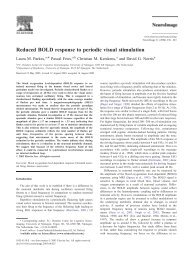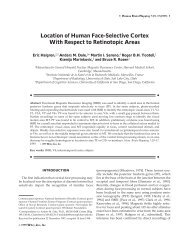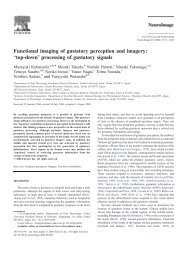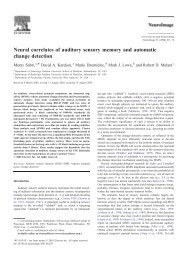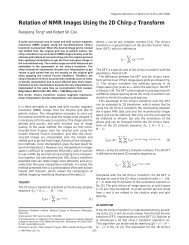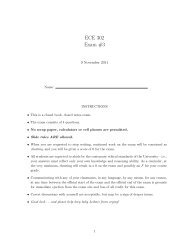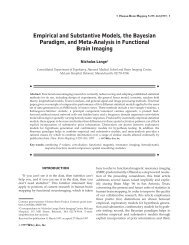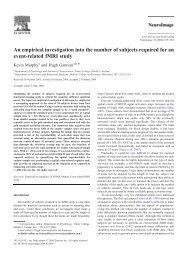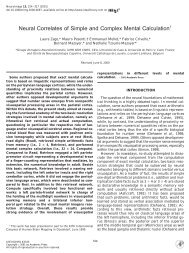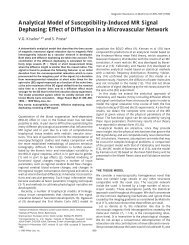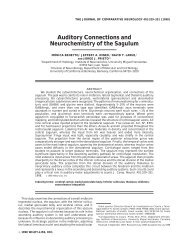Bias and Efficiency in fMRI Time-Series Analysis - Purdue University
Bias and Efficiency in fMRI Time-Series Analysis - Purdue University
Bias and Efficiency in fMRI Time-Series Analysis - Purdue University
Create successful ePaper yourself
Turn your PDF publications into a flip-book with our unique Google optimized e-Paper software.
NeuroImage 12, 196–208 (2000)<br />
doi:10.1006/nimg.2000.0609, available onl<strong>in</strong>e at http://www.idealibrary.com on<br />
To Smooth or Not to Smooth?<br />
<strong>Bias</strong> <strong>and</strong> <strong>Efficiency</strong> <strong>in</strong> <strong>fMRI</strong> <strong>Time</strong>-<strong>Series</strong> <strong>Analysis</strong><br />
K. J. Friston,* O. Josephs,* E. Zarahn,† A. P. Holmes,* S. Rouquette,‡ <strong>and</strong> J.-B. Pol<strong>in</strong>e‡<br />
*The Wellcome Department of Cognitive Neurology, Institute of Neurology, Queen Square, London WC1N 3BG, United K<strong>in</strong>gdom;<br />
†Department of Neurology, <strong>University</strong> of Pennsylvania, Philadelphia, Pennsylvania 19104; <strong>and</strong><br />
‡CEA/DSV/DRM/SHFJ, 4 Place General Leclerc, 91406 Orsay, France<br />
Received July 28, 1999<br />
This paper concerns temporal filter<strong>in</strong>g <strong>in</strong> <strong>fMRI</strong> timeseries<br />
analysis. Whiten<strong>in</strong>g serially correlated data is<br />
the most efficient approach to parameter estimation.<br />
However, if there is a discrepancy between the assumed<br />
<strong>and</strong> the actual correlations, whiten<strong>in</strong>g can render<br />
the analysis exquisitely sensitive to bias when estimat<strong>in</strong>g<br />
the st<strong>and</strong>ard error of the ensu<strong>in</strong>g parameter<br />
estimates. This bias, although not expressed <strong>in</strong> terms<br />
of the estimated responses, has profound effects on<br />
any statistic used for <strong>in</strong>ference. The special constra<strong>in</strong>ts<br />
of <strong>fMRI</strong> analysis ensure that there will always<br />
be a misspecification of the assumed serial correlations.<br />
One resolution of this problem is to filter the<br />
data to m<strong>in</strong>imize bias, while ma<strong>in</strong>ta<strong>in</strong><strong>in</strong>g a reasonable<br />
degree of efficiency. In this paper we present expressions<br />
for efficiency (of parameter estimation) <strong>and</strong> bias<br />
(<strong>in</strong> estimat<strong>in</strong>g st<strong>and</strong>ard error) <strong>in</strong> terms of assumed<br />
<strong>and</strong> actual correlation structures <strong>in</strong> the context of the<br />
general l<strong>in</strong>ear model. We show that: (i) Whiten<strong>in</strong>g<br />
strategies can result <strong>in</strong> profound bias <strong>and</strong> are therefore<br />
probably precluded <strong>in</strong> parametric <strong>fMRI</strong> data analyses.<br />
(ii) B<strong>and</strong>-pass filter<strong>in</strong>g, <strong>and</strong> implicitly smooth<strong>in</strong>g,<br />
has an important role <strong>in</strong> protect<strong>in</strong>g aga<strong>in</strong>st <strong>in</strong>ferential<br />
bias. © 2000 Academic Press<br />
Key Words: functional neuroimag<strong>in</strong>g; <strong>fMRI</strong>; bias; efficiency;<br />
filter<strong>in</strong>g; convolution; <strong>in</strong>ference.<br />
INTRODUCTION<br />
This paper is about serial correlations <strong>in</strong> <strong>fMRI</strong> time<br />
series <strong>and</strong> their impact upon the estimations of, <strong>and</strong><br />
<strong>in</strong>ferences about, evoked hemodynamic responses. In<br />
Friston et al. (1994), we <strong>in</strong>troduced the statistical complications<br />
that arise, <strong>in</strong> the context of the general l<strong>in</strong>ear<br />
model (or l<strong>in</strong>ear time <strong>in</strong>variant systems), due to<br />
temporal autocorrelations or “smoothness” <strong>in</strong> <strong>fMRI</strong><br />
time series. S<strong>in</strong>ce that time a number of approaches to<br />
these <strong>in</strong>tr<strong>in</strong>sic serial correlations have been proposed<br />
<strong>and</strong> our own approach has changed substantially over<br />
the years. In this paper we describe briefly the sources<br />
of correlations <strong>in</strong> <strong>fMRI</strong> error terms <strong>and</strong> consider different<br />
ways of deal<strong>in</strong>g with them. In particular we consider<br />
the importance of filter<strong>in</strong>g the data to condition<br />
the correlation structure despite the fact that remov<strong>in</strong>g<br />
correlations (i.e., whiten<strong>in</strong>g) would be more efficient.<br />
These issues are becom<strong>in</strong>g <strong>in</strong>creas<strong>in</strong>gly important with<br />
the advent of event-related <strong>fMRI</strong> that typically evokes<br />
responses <strong>in</strong> the higher frequency range (Paradis et al.,<br />
1998).<br />
This paper is divided <strong>in</strong>to three sections. The first<br />
describes the nature of, <strong>and</strong> background to, serial correlations<br />
<strong>in</strong> <strong>fMRI</strong> <strong>and</strong> the strategies that have been<br />
adopted to accommodate them. The second section<br />
comments briefly on the implications for optimum experimental<br />
design <strong>and</strong> the third section deals, <strong>in</strong><br />
greater depth, with temporal filter<strong>in</strong>g strategies <strong>and</strong><br />
their impact on efficiency <strong>and</strong> robustness. In this section<br />
we deal first with efficiency <strong>and</strong> bias for a s<strong>in</strong>gle<br />
serially correlated time series <strong>and</strong> then consider the<br />
implications of spatially vary<strong>in</strong>g serial correlations<br />
over voxels.<br />
SERIAL CORRELATIONS IN <strong>fMRI</strong><br />
<strong>fMRI</strong> time series can be viewed as a l<strong>in</strong>ear admixture<br />
of signal <strong>and</strong> noise. Signal corresponds to neuronally<br />
mediated hemodynamic changes that can be modeled<br />
as a l<strong>in</strong>ear (Friston et al., 1994) or nonl<strong>in</strong>ear (Friston et<br />
al., 1998) convolution of some underly<strong>in</strong>g neuronal process,<br />
respond<strong>in</strong>g to changes <strong>in</strong> experimental factors.<br />
<strong>fMRI</strong> noise has many components that render it rather<br />
complicated <strong>in</strong> relation to other neurophysiological<br />
measurements. These <strong>in</strong>clude neuronal <strong>and</strong> nonneuronal<br />
sources. Neuronal noise refers to neurogenic signal<br />
not modeled by the explanatory variables <strong>and</strong> occupies<br />
the same part of the frequency spectrum as the hemodynamic<br />
signal itself. These noise components may be<br />
unrelated to the experimental design or reflect variations<br />
about evoked responses that are <strong>in</strong>adequately<br />
modeled <strong>in</strong> the design matrix. Nonneuronal components<br />
can have a physiological (e.g., Meyer’s waves) or<br />
1053-8119/00 $35.00<br />
Copyright © 2000 by Academic Press<br />
All rights of reproduction <strong>in</strong> any form reserved.<br />
196
<strong>fMRI</strong> TIME-SERIES ANALYSIS<br />
197<br />
nonphysiological orig<strong>in</strong> <strong>and</strong> comprise both white [e.g.,<br />
thermal (Johnston) noise] <strong>and</strong> colored components<br />
[e.g., pulsatile motion of the bra<strong>in</strong> caused by cardiac<br />
cycles or local modulation of the static magnetic field<br />
(B 0 ) by respiratory movement]. These effects are typically<br />
low frequency (Holmes et al., 1997) or wide b<strong>and</strong><br />
(e.g., aliased cardiac-locked pulsatile motion). The superposition<br />
of these colored components creates serial<br />
correlations among the error terms <strong>in</strong> the statistical<br />
model (denoted by V i below) that can have a severe<br />
effect on sensitivity when try<strong>in</strong>g to detect experimental<br />
effects. Sensitivity depends upon (i) the relative<br />
amounts of signal <strong>and</strong> noise <strong>and</strong> (ii) the efficiency of the<br />
experimental design <strong>and</strong> analysis. Sensitivity also depends<br />
on the choice of the estimator (e.g., l<strong>in</strong>ear least<br />
squares vs Gauss–Markov) as well as the validity of<br />
the assumptions regard<strong>in</strong>g the distribution of the errors<br />
(e.g., the Gauss–Markov estimator is the maximum<br />
likelihood estimator only if the errors are multivariate<br />
Gaussian as assumed <strong>in</strong> this paper).<br />
There are three important considerations that arise<br />
from this signal process<strong>in</strong>g perspective on <strong>fMRI</strong> time<br />
series: The first perta<strong>in</strong>s to optimum experimental design,<br />
the second to optimum filter<strong>in</strong>g of the time series<br />
to obta<strong>in</strong> the most efficient parameter estimates, <strong>and</strong><br />
the third to the robustness of the statistical <strong>in</strong>ferences<br />
about the parameter estimates that ensue. In what<br />
follows we will show that the conditions for both high<br />
efficiency <strong>and</strong> robustness imply a variance–bias tradeoff<br />
that can be controlled by temporal filter<strong>in</strong>g. The<br />
particular variance <strong>and</strong> bias considered <strong>in</strong> this paper<br />
perta<strong>in</strong> to the variance of the parameter estimates <strong>and</strong><br />
the bias <strong>in</strong> estimators of this variance.<br />
The Background to Serial Correlations<br />
Serial correlations were considered <strong>in</strong>itially from the<br />
po<strong>in</strong>t of view of statistical <strong>in</strong>ference. It was suggested<br />
that <strong>in</strong>stead of us<strong>in</strong>g the number of scans as the degrees<br />
of freedom for any statistical analysis, the effective<br />
degrees of freedom should be used (Friston et al.,<br />
1994). The effective degrees of freedom were based<br />
upon some estimate of the serial correlations <strong>and</strong> entered<br />
<strong>in</strong>to the statistic so that its distribution under<br />
the null hypothesis conformed more closely to that<br />
expected under parametric assumptions. The primary<br />
concern at this stage was the validity of the <strong>in</strong>ferences<br />
that obta<strong>in</strong>ed. This heuristic approach was subsequently<br />
corrected <strong>and</strong> ref<strong>in</strong>ed, culm<strong>in</strong>at<strong>in</strong>g <strong>in</strong> the<br />
framework described <strong>in</strong> Worsley <strong>and</strong> Friston (1995). In<br />
Worsley <strong>and</strong> Friston (1995) a general l<strong>in</strong>ear model was<br />
described that accommodated serial correlations, <strong>in</strong><br />
terms of both parameter estimation <strong>and</strong> <strong>in</strong>ference us<strong>in</strong>g<br />
the associated statistics. In order to avoid estimat<strong>in</strong>g<br />
the <strong>in</strong>tr<strong>in</strong>sic serial correlations, the data were convolved<br />
with a Gaussian smooth<strong>in</strong>g kernel to impose an<br />
approximately known correlation structure. The critical<br />
consideration at this stage was robustness <strong>in</strong> the<br />
face of errors <strong>in</strong> estimat<strong>in</strong>g the correlations. Bullmore<br />
et al. (1996) then proposed an alternative approach,<br />
whereby the estimated temporal autocorrelation structure<br />
was used to prewhiten the data, prior to fitt<strong>in</strong>g a<br />
general l<strong>in</strong>ear model with assumed identical <strong>and</strong> <strong>in</strong>dependently<br />
distributed error terms. This proposal was<br />
motivated by considerations of efficiency. Validity <strong>and</strong><br />
robustness were ensured <strong>in</strong> the special case of the<br />
analysis proposed by Bullmore et al. (1996) because<br />
they used r<strong>and</strong>omization strategies for <strong>in</strong>ference. 1<br />
Variations on an autoregressive characterization of serial<br />
correlations then appeared. For example Locascio<br />
et al. (1997) used autoregressive mov<strong>in</strong>g average<br />
(ARMA) models on a voxel-by-voxel basis. Purdon <strong>and</strong><br />
Weisskoff (1998) suggested the use of an AR(1) plus<br />
white noise model. In the past years a number of empirical<br />
characterizations of the noise have been described.<br />
Among the more compell<strong>in</strong>g is a modified 1/f<br />
characterization 2 of Aguirre et al. (1997) <strong>and</strong> Zarahn et<br />
al. (1997) (see Appendix A for a more formal description<br />
of autoregressive <strong>and</strong> modified 1/f models). In<br />
short, there have emerged a number of apparently<br />
disparate approaches to deal<strong>in</strong>g with, <strong>and</strong> model<strong>in</strong>g,<br />
noise <strong>in</strong> <strong>fMRI</strong> time series. Which of these approaches or<br />
models is best? The answer to this question can be<br />
framed <strong>in</strong> terms of efficiency <strong>and</strong> robustness.<br />
Validity, <strong>Efficiency</strong>, <strong>and</strong> Robustness<br />
Validity refers to the validity of the statistical <strong>in</strong>ference<br />
or the accuracy of the P values that are obta<strong>in</strong>ed<br />
from an analysis. A test is valid if the false-positive<br />
rate is less than the nom<strong>in</strong>al specificity (usually <br />
0.05). An exact test has a false-positive rate that is<br />
equal to the specificity. The efficiency of a test relates<br />
to the estimation of the parameters of the statistical<br />
model employed. This estimation is more efficient<br />
when the variability of the estimated parameters is<br />
smaller. A test that rema<strong>in</strong>s valid for a given departure<br />
from an assumption is said to be robust to violation of<br />
that assumption. If a test becomes <strong>in</strong>valid, when the<br />
assumptions no longer hold, then it is not a robust test.<br />
In general, considerations of efficiency are subord<strong>in</strong>ate<br />
to ensur<strong>in</strong>g that the test is valid under the normal<br />
circumstances of its use. If these circumstances <strong>in</strong>cur<br />
some deviation from the assumptions beh<strong>in</strong>d the test,<br />
robustness becomes the primary concern.<br />
1 There is an argument that the permutation of scans implicit <strong>in</strong><br />
the r<strong>and</strong>omization procedure is <strong>in</strong>valid if serial correlations persist<br />
after whiten<strong>in</strong>g: Strictly speak<strong>in</strong>g the scans are not <strong>in</strong>terchangeable.<br />
The strategy adopted by Bullmore et al. (1996) further assumes the<br />
same error variance for every voxel. This greatly reduces computational<br />
load but is not an assumption that everyone accepts <strong>in</strong> <strong>fMRI</strong>.<br />
2 This class of model should not be confused with conventional 1/f<br />
processes with fractal scal<strong>in</strong>g properties, which are 1/f <strong>in</strong> power. The<br />
models referred to as “modified 1/f models” <strong>in</strong> this paper are 1/f <strong>in</strong><br />
amplitude.
198 FRISTON ET AL.<br />
event-related design has more high-frequency components<br />
<strong>and</strong> this renders it less efficient than the block<br />
design from a statistical perspective (but more useful<br />
from other perspectives). The regressors <strong>in</strong> Fig. 1 will<br />
be used later to illustrate the role of temporal filter<strong>in</strong>g.<br />
TEMPORAL FILTERING<br />
FIG. 1. Left: A canonical hemodynamic response function (HRF).<br />
The HRF <strong>in</strong> this <strong>in</strong>stance comprises the sum of two gamma functions<br />
model<strong>in</strong>g a peak at 6 s <strong>and</strong> a subsequent undershoot. Right: Spectral<br />
density associated with the HRF expressed as a function of 1/frequency<br />
or period length. This spectral density is l() 2 where l() is<br />
the HRF transfer function.<br />
This section deals with temporal filter<strong>in</strong>g <strong>and</strong> its<br />
effect on efficiency <strong>and</strong> <strong>in</strong>ferential bias. We start with<br />
the general l<strong>in</strong>ear model <strong>and</strong> derive expressions for<br />
efficiency <strong>and</strong> bias <strong>in</strong> terms of assumed <strong>and</strong> actual<br />
correlations <strong>and</strong> some applied filter. The next subsection<br />
shows that the most efficient filter<strong>in</strong>g scheme (a<br />
m<strong>in</strong>imum variance filter) <strong>in</strong>troduces profound bias <strong>in</strong>to<br />
the estimates of st<strong>and</strong>ard error used to construct the<br />
test statistic. This results <strong>in</strong> tests that are <strong>in</strong>sensitive<br />
OPTIMUM EXPERIMENTAL DESIGN<br />
Any l<strong>in</strong>ear time <strong>in</strong>variant model (e.g., Friston et al.,<br />
1994; Boynton et al., 1996) of neuronally mediated<br />
signals <strong>in</strong> <strong>fMRI</strong> suggests that only those experimental<br />
effects whose frequency structure survives convolution<br />
with the hemodynamic response function (HRF) can be<br />
estimated with any efficiency. Experimental variance<br />
should therefore be elicited with reference to the transfer<br />
function of the HRF. The correspond<strong>in</strong>g frequency<br />
profile of a canonical transfer function is shown <strong>in</strong> Fig.<br />
1 (right). It is clear that frequencies around 1/32 Hz<br />
will be preserved, follow<strong>in</strong>g convolution, relative to<br />
other frequencies. This frequency characterizes periodic<br />
designs with 32-s periods (i.e., 16-s epochs). Generally<br />
the first objective of experimental design is to<br />
comply with the natural constra<strong>in</strong>ts imposed by the<br />
HRF <strong>and</strong> to ensure that experimental variance occupies<br />
these <strong>in</strong>termediate frequencies.<br />
Clearly there are other important constra<strong>in</strong>ts. An<br />
important one here is the frequency structure of noise,<br />
which is much more prevalent at low frequencies (e.g.,<br />
1/64 Hz <strong>and</strong> lower). This suggests that the experimental<br />
frequencies, which one can control by experimental<br />
design, should avoid these low-frequency ranges. Other<br />
constra<strong>in</strong>ts are purely experimental; for example, psychological<br />
constra<strong>in</strong>ts motivate the use of event-related<br />
designs that evoke higher frequency signals (Paradis et<br />
al., 1998) relative to equivalent block designs. Typical<br />
regressors for an epoch- or block-related design <strong>and</strong> an<br />
event-related design are shown <strong>in</strong> Fig. 2. The epochrelated<br />
design is shown at the top <strong>and</strong> comprises a<br />
box-car <strong>and</strong> its temporal derivative, convolved with a<br />
canonical HRF (shown on the left <strong>in</strong> Fig. 1). An eventrelated<br />
design, with the same number of trials presented<br />
<strong>in</strong> a stochastic fashion, is shown at the bottom.<br />
Aga<strong>in</strong> the regressors correspond to an underly<strong>in</strong>g set of<br />
delta functions (“stick” function) <strong>and</strong> their temporal<br />
derivatives convolved with a canonical HRF. The<br />
FIG. 2. Regressors for an epoch-related or block design (top) <strong>and</strong><br />
an event-related design (bottom) with 128 scans <strong>and</strong> a TR of 1.7 s.<br />
Both sets of regressors were constructed by convolv<strong>in</strong>g the appropriate<br />
stimulus function (box-car for the block design <strong>and</strong> a stick function<br />
for the event-related design) <strong>and</strong> its temporal derivative with<br />
the canonical HRF depicted <strong>in</strong> Fig. 1. These regressors have been<br />
orthogonalized <strong>and</strong> Euclidean normalized.
<strong>fMRI</strong> TIME-SERIES ANALYSIS<br />
199<br />
or potentially <strong>in</strong>valid (i.e., not robust). The position<br />
adopted <strong>in</strong> this paper is that, for <strong>fMRI</strong> data analysis, a<br />
m<strong>in</strong>imum variance filter is not appropriate. Instead we<br />
would like to f<strong>in</strong>d a m<strong>in</strong>imum bias filter. This is difficult<br />
because one needs to know how the serial correlations<br />
that are likely to be encountered deviate from the<br />
assumed form. The next subsection presents a way of<br />
estimat<strong>in</strong>g the expected bias <strong>and</strong> efficiency, given the<br />
probability distribution of the <strong>in</strong>tr<strong>in</strong>sic correlations.<br />
Us<strong>in</strong>g empirical estimates of this distribution it is<br />
shown that suppress<strong>in</strong>g both high <strong>and</strong> low frequencies<br />
with b<strong>and</strong>-pass filter<strong>in</strong>g is required to m<strong>in</strong>imize bias.<br />
The expected values for bias <strong>and</strong> efficiency are then<br />
used to compare three filter<strong>in</strong>g strategies, (i) whiten<strong>in</strong>g,<br />
(ii) high-pass, <strong>and</strong> (iii) b<strong>and</strong>-pass (i.e., high pass<br />
with smooth<strong>in</strong>g) filter<strong>in</strong>g, under different models of the<br />
correlations. In brief it will be shown that supplement<strong>in</strong>g<br />
high-pass filter<strong>in</strong>g with smooth<strong>in</strong>g has an important<br />
role <strong>in</strong> reduc<strong>in</strong>g bias whatever model is assumed.<br />
This section concludes by not<strong>in</strong>g that m<strong>in</strong>imiz<strong>in</strong>g bias<br />
over a range of deviations from the assumed form for<br />
the correlations also renders bias less sensitive to spatial<br />
variations <strong>in</strong> serial correlations from voxel to voxel.<br />
<strong>Efficiency</strong> <strong>and</strong> <strong>Bias</strong><br />
Here we provide expressions for the efficiency <strong>and</strong><br />
bias for any experimental design, embodied <strong>in</strong> the explanatory<br />
variables or regressors that comprise the<br />
design matrix X <strong>and</strong> any contrast or compound of parameter<br />
estimates specified with a vector of contrast<br />
weights. Consider the general l<strong>in</strong>ear model<br />
Sy SX SK i z, (1)<br />
where y isa(n 1) response variable (measured <strong>fMRI</strong><br />
signal at any voxel) <strong>and</strong> S is an extr<strong>in</strong>sic or applied<br />
temporal filter matrix. If S has a Toeplitz form then it<br />
can be considered as an applied (de)convolution. However,<br />
generally S can take any form. A dist<strong>in</strong>ction is<br />
made between the true <strong>in</strong>tr<strong>in</strong>sic correlations <strong>and</strong> those<br />
assumed. These correlations are characterized by the<br />
(n n) convolution matrices K i <strong>and</strong> K a , respectively,<br />
with an ensu<strong>in</strong>g noise process K i z where z is an <strong>in</strong>dependent<br />
<strong>in</strong>novation (0, 2 I).<br />
The correspond<strong>in</strong>g autocorrelation matrices are V i <br />
K i K i T <strong>and</strong> V a K a K a T . The general least-squares estimator<br />
of the parameters is<br />
ˆ GLS X T S T SX 1 SX T Sy SX Sy, (2)<br />
where <br />
denotes the pseudo<strong>in</strong>verse. The efficiency of<br />
estimat<strong>in</strong>g a particular contrast of parameters is <strong>in</strong>versely<br />
proportional to the contrast variance,<br />
varc T ˆ GLS 2 c T SX SV i S T SX T c, (3)<br />
where c is a vector of contrast weights. One might<br />
simply proceed by choos<strong>in</strong>g S to maximize efficiency or,<br />
equivalently, m<strong>in</strong>imize contrast variance (see “M<strong>in</strong>imum<br />
Variance Filters”). However, there is another<br />
important consideration here: any statistic used to<br />
make an <strong>in</strong>ference about the significance of the contrast<br />
is a function of that contrast <strong>and</strong> an estimate of its<br />
variance. This second estimate depends upon an estimate<br />
of 2 <strong>and</strong> an estimate of the <strong>in</strong>tr<strong>in</strong>sic correlations<br />
V i (i.e., V a ). The estimator of the contrast variance will<br />
be subject to bias if there is a mismatch between the<br />
assumed <strong>and</strong> the actual correlations. Such bias would<br />
<strong>in</strong>validate the use of theoretical distributions, of test<br />
statistics derived from the contrast, used to control<br />
false-positive rates.<br />
<strong>Bias</strong> can be expressed <strong>in</strong> terms of the proportional<br />
difference between the true contrast variance <strong>and</strong> the<br />
expectation of its estimator (see Appendix B for details),<br />
<strong>Bias</strong>S, V i <br />
1 traceRSV iS T c T SX SV a S T SX T c<br />
traceRSV a S T c T SX SV i S T SX T c , (4)<br />
where R I SX(SX) is a residual-form<strong>in</strong>g matrix.<br />
When bias is less than zero the estimated st<strong>and</strong>ard<br />
error is too small <strong>and</strong> the ensu<strong>in</strong>g T or F statistic will<br />
be too large, lead<strong>in</strong>g to capricious <strong>in</strong>ferences (i.e., false<br />
positives). When bias is greater than zero the <strong>in</strong>ference<br />
will be too conservative (but still valid). In short if K i <br />
K a then bias will depend on S. IfK i K a then bias <br />
0 but efficiency still depends upon S.<br />
M<strong>in</strong>imum Variance Filters<br />
Conventional signal process<strong>in</strong>g approaches <strong>and</strong> estimation<br />
theory dictate that whiten<strong>in</strong>g the data engenders<br />
the most efficient parameter estimation. This corresponds<br />
to filter<strong>in</strong>g with a convolution matrix S that<br />
is the <strong>in</strong>verse of the <strong>in</strong>tr<strong>in</strong>sic convolution matrix K i<br />
(where K i V 1/2 i ). The result<strong>in</strong>g parameter estimates<br />
are optimally efficient among all l<strong>in</strong>ear, unbiased estimators<br />
<strong>and</strong> correspond to the maximum likelihood estimators<br />
under Gaussian assumptions. More formally,<br />
the general least-squares estimators ˆ GLS are then<br />
equivalent to the Gauss–Markov or l<strong>in</strong>ear m<strong>in</strong>imum<br />
variance estimators ˆ GM (Lawson <strong>and</strong> Hanson, 1974).<br />
In order to whiten the data one needs to know, or<br />
estimate, the <strong>in</strong>tr<strong>in</strong>sic correlation structure. This reduces<br />
to f<strong>in</strong>d<strong>in</strong>g an appropriate model for the autocorrelation<br />
function or spectral density of the error terms<br />
<strong>and</strong> then estimat<strong>in</strong>g the parameters of that model.<br />
Clearly one can never know the true structure but we<br />
can compare different models to characterize their relative<br />
strengths <strong>and</strong> weaknesses. In this paper we will<br />
take a high-order (16) autoregressive model as the
200 FRISTON ET AL.<br />
FIG. 3. Spectral densities (top) <strong>and</strong> correspond<strong>in</strong>g autocorrelation<br />
functions (bottom) for the residual terms of a <strong>fMRI</strong> time series<br />
averaged over 512 voxels. Three cases are shown: (i) An AR(16)<br />
model estimated us<strong>in</strong>g the Yule–Walker method (this is taken to be<br />
a good approximation to the true correlations). The “bump” <strong>in</strong> the<br />
spectrum at around 1/32 Hz may reflect harmonics of r<strong>and</strong>om variations<br />
<strong>in</strong> trial-to-trial responses (every 16 s). (ii) An AR(1) model<br />
estimate us<strong>in</strong>g the same method. (iii) For a model of the form (q 1 /f <br />
q 2 ) where f is frequency <strong>in</strong> Hz. These data came from a s<strong>in</strong>gle-subject,<br />
event-related, s<strong>in</strong>gle-word-presentation <strong>fMRI</strong> study acquired with<br />
multislice EPI at 2 T with a TR of 1.7 s. The words were presented<br />
every 16 s. The data were globally normalized, <strong>and</strong> fitted eventrelated<br />
responses (Josephs et al., 1997) were removed. The 512<br />
voxels were selected on the basis of a nontrivial response to acoustic<br />
stimulation, based on the F ratio <strong>in</strong> a conventional SPM analysis<br />
(P 0.001 uncorrected). This ensured that the ensu<strong>in</strong>g gray-matter<br />
voxels represented a fairly homogeneous population <strong>in</strong> terms of their<br />
functional specialization.<br />
“gold st<strong>and</strong>ard” <strong>and</strong> evaluate simpler, but commonly<br />
used, models <strong>in</strong> relation to it. In other words we will<br />
consider the AR(16) model as an approximation to the<br />
true underly<strong>in</strong>g correlations. The problem of estimat<strong>in</strong>g<br />
serial correlations is highlighted <strong>in</strong> Fig. 3. Here the<br />
residuals from a long (512-scan, TR 1.7 s) time series<br />
were used to estimate the spectral density <strong>and</strong> associated<br />
autocorrelation functions (where one is the<br />
Fourier transform of the other) us<strong>in</strong>g the Yule–Walker<br />
method with an autoregression order of 16 (see Appendix<br />
A). The data came from a s<strong>in</strong>gle-subject eventrelated<br />
study us<strong>in</strong>g sparse s<strong>in</strong>gle-word presentations<br />
every 16 s. Evoked responses were removed follow<strong>in</strong>g<br />
global normalization. Estimates of the autocorrelation<br />
functions <strong>and</strong> spectral densities us<strong>in</strong>g a commonly assumed<br />
AR(1) model (Bullmore et al., 1996) <strong>and</strong> a modified<br />
1/f model (Zarahn et al., 1997) are also shown. The<br />
AR(1) is <strong>in</strong>adequate <strong>in</strong> that it fails to model either<br />
long-range (i.e., low frequencies) or <strong>in</strong>termediate correlations.<br />
The modified 1/f model shown here is a good<br />
approximation for the short-range <strong>and</strong> <strong>in</strong>termediate<br />
correlations but fails to model the long-range correlations<br />
as well as it could. Any discrepancy between the<br />
assumed <strong>and</strong> the actual correlation structure means<br />
that, when the data are whitened <strong>in</strong> accord with the<br />
assumed models, the st<strong>and</strong>ard error of the contrast is<br />
biased. This leads directly to bias <strong>in</strong> the ensu<strong>in</strong>g statistics.<br />
For example the T statistic is simply the quotient<br />
of the contrast <strong>and</strong> its estimated st<strong>and</strong>ard error.<br />
It should be noted that the simple models would fit<br />
much better if drifts were first removed from the time<br />
series. However, this drift removal corresponds to<br />
high-pass filter<strong>in</strong>g <strong>and</strong> we want to make the po<strong>in</strong>t that<br />
filter<strong>in</strong>g is essential for reduc<strong>in</strong>g the discrepancy between<br />
assumed <strong>and</strong> actual correlations (see below).<br />
This bias is illustrated <strong>in</strong> Fig. 4 under a variety of<br />
model-specific m<strong>in</strong>imum-variance filters. Here the regressors<br />
from the epoch- <strong>and</strong> event-related designs <strong>in</strong><br />
Fig. 2 were used as the design matrix X, to calculate<br />
the contrast variance <strong>and</strong> bias <strong>in</strong> the estimate of this<br />
variance accord<strong>in</strong>g to Eq. (3) <strong>and</strong> Eq. (4), where<br />
V i V AR(16) ,<br />
V a V i<br />
V AR(1)<br />
V 1/f<br />
1<br />
1<br />
i<br />
“correct” model<br />
1<br />
K<br />
, S K AR(1) AR1 model<br />
1<br />
.<br />
K 1/f<br />
1/f model<br />
1 “none”<br />
The variances <strong>in</strong> Fig. 4 have been normalized by the<br />
m<strong>in</strong>imum variance possible (i.e., that of the “correct”<br />
model). The biases are expressed <strong>in</strong> terms of the proportion<br />
of variance <strong>in</strong>correctly estimated. Obviously<br />
the AR(16) model gives maximum efficiency <strong>and</strong> no<br />
bias (bias 0) because we have used the AR(16) estimates<br />
as an approximation to the actual correlations.<br />
Any deviation from this “correct” form reduces efficiency<br />
<strong>and</strong> <strong>in</strong>flates the contrast variance. Note that<br />
misspecify<strong>in</strong>g the form for the serial correlations has<br />
<strong>in</strong>flated the contrast variance more for the event-related<br />
design (bottom) relative to the epoch-related design<br />
(top). This is because the regressors <strong>in</strong> the epochrelated<br />
design correspond more closely to eigenvectors<br />
of the <strong>in</strong>tr<strong>in</strong>sic autocorrelation matrix (see Worsley
<strong>fMRI</strong> TIME-SERIES ANALYSIS<br />
201<br />
because a large number of scans enter <strong>in</strong>to the estimation<br />
<strong>in</strong> fixed-effect analyses, <strong>and</strong> r<strong>and</strong>om-effects analyses<br />
(with fewer degrees of freedom) do not have to<br />
contend with serial correlations.<br />
FIG. 4. Efficiencies <strong>and</strong> biases computed accord<strong>in</strong>g to Eq. (3) <strong>and</strong><br />
Eq. (4) <strong>in</strong> the ma<strong>in</strong> text for the regressors <strong>in</strong> Fig. 2 <strong>and</strong> contrasts of<br />
[1 0] <strong>and</strong> [0 1] for three models of <strong>in</strong>tr<strong>in</strong>sic correlations [AR(16),<br />
AR(1), <strong>and</strong> the modified 1/f models] <strong>and</strong> assum<strong>in</strong>g they do not exist<br />
(“none”). The results are for the Gauss–Markov estimators (i.e.,<br />
us<strong>in</strong>g a whiten<strong>in</strong>g strategy based on the appropriate model <strong>in</strong> each<br />
case) us<strong>in</strong>g the first model [AR(16)] as an approximation to the true<br />
correlations. The contrast variances have been normalized to the<br />
m<strong>in</strong>imum atta<strong>in</strong>able. The bias <strong>and</strong> <strong>in</strong>creased contrast variance <strong>in</strong>duced<br />
result from adopt<strong>in</strong>g a whiten<strong>in</strong>g strategy when there is a<br />
discrepancy between the actual <strong>and</strong> the assumed <strong>in</strong>tr<strong>in</strong>sic correlations.<br />
<strong>and</strong> Friston, 1995). Generally if the regressors conform<br />
to these eigenvectors then there is no loss of efficiency.<br />
The bias <strong>in</strong>curred by mis-specification can be substantial,<br />
result<strong>in</strong>g <strong>in</strong> an over- [AR(1)] or under- (1/f <strong>and</strong><br />
“none”) estimation of the contrast variance lead<strong>in</strong>g, <strong>in</strong><br />
turn, to <strong>in</strong>exact tests us<strong>in</strong>g the associated T statistic<br />
that are unduly <strong>in</strong>sensitive [AR(1)] or <strong>in</strong>valid (1/f <strong>and</strong><br />
“none”). The effect is not trivial. For example the bias<br />
engendered by assum<strong>in</strong>g an AR(1) form <strong>in</strong> Fig. 4 is<br />
about 24%. This would result <strong>in</strong> about a 10% reduction<br />
of T values <strong>and</strong> could have profound effects on <strong>in</strong>ference.<br />
In summary the use of m<strong>in</strong>imum variance, or maximum<br />
efficiency, filters can lead to <strong>in</strong>valid tests. This<br />
suggests that the use of whiten<strong>in</strong>g is <strong>in</strong>appropriate <strong>and</strong><br />
the more important objective is to adopt filter<strong>in</strong>g strategies<br />
that m<strong>in</strong>imize bias to ensure that the tests are<br />
robust <strong>in</strong> the face of misspecified autocorrelation structures<br />
(i.e., their validity is reta<strong>in</strong>ed). The m<strong>in</strong>imum<br />
bias approach is even more tenable given that sensitivity<br />
<strong>in</strong> <strong>fMRI</strong> is not generally a great concern. This is<br />
M<strong>in</strong>imum <strong>Bias</strong> Filters<br />
There are two fundamental problems when try<strong>in</strong>g to<br />
model <strong>in</strong>tr<strong>in</strong>sic correlations: (i) one generally does not<br />
know the true <strong>in</strong>tr<strong>in</strong>sic correlations <strong>and</strong> (ii) even if they<br />
were known for any given voxel time series, adopt<strong>in</strong>g<br />
the same assumptions for all voxels will lead to bias<br />
<strong>and</strong> loss of efficiency because each voxel has a different<br />
correlation structure (e.g., bra<strong>in</strong>-stem voxels will be<br />
subject to pulsatile effects, ventricular voxels will be<br />
subject to CSF flow artifacts, white matter voxels will<br />
not be subject to neurogenic noise). It should be noted<br />
that very reasonable methods have been proposed for<br />
local estimates of spatially vary<strong>in</strong>g noise (e.g., Lange<br />
<strong>and</strong> Zeger, 1997). However, <strong>in</strong> this paper we assume<br />
that computational, <strong>and</strong> other, constra<strong>in</strong>ts require us<br />
to use the same statistical model for all voxels.<br />
One solution to the “bias problem” is described <strong>in</strong><br />
Worsley <strong>and</strong> Friston (1995) <strong>and</strong> <strong>in</strong>volves condition<strong>in</strong>g<br />
the serial correlations by smooth<strong>in</strong>g. This effectively<br />
imposes a structure on the <strong>in</strong>tr<strong>in</strong>sic correlations that<br />
renders the difference between the assumed <strong>and</strong> the<br />
actual correlations less severe. Although generally less<br />
efficient, the ensu<strong>in</strong>g <strong>in</strong>ferences are less biased <strong>and</strong><br />
therefore more robust. The loss of efficiency can be<br />
m<strong>in</strong>imized by appropriate experimental design <strong>and</strong><br />
choos<strong>in</strong>g a suitable filter S. In other words there are<br />
certa<strong>in</strong> forms of temporal filter<strong>in</strong>g for which SV i S T <br />
SV a S T even when V i is not known [see Eq. (4)]. These<br />
filters will m<strong>in</strong>imize bias. The problem is to f<strong>in</strong>d a<br />
suitable form for S.<br />
One approach to design<strong>in</strong>g a m<strong>in</strong>imum bias filter is<br />
to treat the <strong>in</strong>tr<strong>in</strong>sic correlation V i , not as an unknown<br />
determ<strong>in</strong>istic variable, but as a r<strong>and</strong>om variable,<br />
whose distributional properties are known or can be<br />
estimated. We can then choose a filter that m<strong>in</strong>imizes<br />
the expected square bias over all V i ,<br />
S MB m<strong>in</strong> arg S S<br />
S biasS, V i 2 pV i dV i .<br />
(5)<br />
Equation (5) says that the ideal filter would m<strong>in</strong>imize<br />
the expected or mean square bias over all <strong>in</strong>tr<strong>in</strong>sic<br />
correlation structures encountered. An expression for<br />
mean square bias <strong>and</strong> the equivalent mean contrast<br />
variance (i.e., 1/efficiency) is provided <strong>in</strong> Appendix C.<br />
This expression uses the first <strong>and</strong> second order moments<br />
of the <strong>in</strong>tr<strong>in</strong>sic autocorrelation function, parameterized<br />
<strong>in</strong> terms of the underly<strong>in</strong>g autoregression co-
202 FRISTON ET AL.<br />
might posit b<strong>and</strong>-pass filter<strong>in</strong>g as a m<strong>in</strong>imum bias<br />
filter. In the limit of very narrow b<strong>and</strong>-pass filter<strong>in</strong>g<br />
the spectral densities of the assumed <strong>and</strong> actual correlations,<br />
after filter<strong>in</strong>g, would be identical <strong>and</strong> bias<br />
would be negligible. Clearly this would be <strong>in</strong>efficient<br />
but suggests that some b<strong>and</strong>-pass filter might be an<br />
appropriate choice. Although there is no s<strong>in</strong>gle universal<br />
m<strong>in</strong>imum bias filter, <strong>in</strong> the sense it will depend on<br />
the design matrix <strong>and</strong> contrasts employed <strong>and</strong> other<br />
data acquisition parameters; one <strong>in</strong>dication of which<br />
frequencies can be usefully attenuated derives from<br />
exam<strong>in</strong><strong>in</strong>g how bias depends on the upper <strong>and</strong> lower<br />
cutoff frequencies of a b<strong>and</strong>-pass filter.<br />
Figure 6 shows the mean square bias <strong>and</strong> mean<br />
contrast variance <strong>in</strong>curred by vary<strong>in</strong>g the upper <strong>and</strong><br />
lower b<strong>and</strong>-pass frequencies. These results are based<br />
on the epoch-related regressors <strong>in</strong> Fig. 2 <strong>and</strong> assume<br />
that the <strong>in</strong>tr<strong>in</strong>sic correlations conform to the AR(16)<br />
estimate. This means that any bias is due to variation<br />
FIG. 5. Characteriz<strong>in</strong>g the variability <strong>in</strong> <strong>in</strong>tr<strong>in</strong>sic correlations.<br />
Top: The 16 partial derivatives of the autocorrelation function with<br />
respect to the eigenvectors of the covariance matrix of the underly<strong>in</strong>g<br />
autoregression coefficients. These represent changes to the autocorrelation<br />
function <strong>in</strong>duced by the pr<strong>in</strong>cipal components of variation<br />
<strong>in</strong>herent <strong>in</strong> the coefficients. The covariances were evaluated over the<br />
voxels described <strong>in</strong> Fig. 2. Lower left: The associated eigenvalue<br />
spectrum. Lower right: The autocorrelation function associated with<br />
the mean of the autoregression coefficients. These characterizations<br />
enter <strong>in</strong>to Eq. (C.3) <strong>in</strong> Appendix C, to estimate the mean square bias<br />
for a given filter.<br />
efficients. More precisely, given the expected<br />
coefficients <strong>and</strong> their covariances, a simple secondorder<br />
approximation to Eq. (5) obta<strong>in</strong>s <strong>in</strong> terms of the<br />
eigenvectors <strong>and</strong> eigenvalues of the AR coefficient covariance<br />
matrix. These characterize the pr<strong>in</strong>cipal variations<br />
about the expected autocorrelation function.<br />
Empirical examples are shown <strong>in</strong> Fig. 5, based on the<br />
variation over gray matter voxels <strong>in</strong> the data used <strong>in</strong><br />
Fig. 2. Here the pr<strong>in</strong>cipal variations, about the expected<br />
autocorrelation function (lower right), are presented<br />
(top) <strong>in</strong> terms of partial derivatives of the autocorrelation<br />
function with respect to the autoregressive<br />
eigenvectors (see Appendix C).<br />
The expressions for mean square bias <strong>and</strong> mean<br />
contrast variance will be used <strong>in</strong> the next subsection to<br />
evaluate the behavior of three filter<strong>in</strong>g schemes <strong>in</strong><br />
relation to each other <strong>and</strong> a number of different correlation<br />
models. First however, we will use them to motivate<br />
the use of b<strong>and</strong>-pass filter<strong>in</strong>g: Intuitively one<br />
FIG. 6. Top: Mean square bias (shown <strong>in</strong> image format <strong>in</strong> <strong>in</strong>set)<br />
as a function of high- <strong>and</strong> low-pass cutoff frequencies def<strong>in</strong><strong>in</strong>g a<br />
b<strong>and</strong>-pass filter. Darker areas correspond to lower bias. Note that<br />
m<strong>in</strong>imum bias atta<strong>in</strong>s when a substantial degree of smooth<strong>in</strong>g or<br />
low-pass filter<strong>in</strong>g is used <strong>in</strong> conjunction with high-pass filter<strong>in</strong>g<br />
(dark area on the middle left). Bottom: As for the top but now<br />
depict<strong>in</strong>g efficiency. The gray scale is arbitrary.
<strong>fMRI</strong> TIME-SERIES ANALYSIS<br />
203<br />
about that estimate <strong>and</strong> not due to specify<strong>in</strong>g an <strong>in</strong>appropriately<br />
simple form for the correlations. 3<br />
The<br />
ranges of upper <strong>and</strong> lower b<strong>and</strong>-pass frequencies were<br />
chosen to avoid encroach<strong>in</strong>g on frequencies that conta<strong>in</strong><br />
signal. This ensured that efficiency was not severely<br />
compromised. The critical th<strong>in</strong>g to note from<br />
Fig. 6 is that the effects of low-pass <strong>and</strong> high-pass<br />
filter<strong>in</strong>g are not l<strong>in</strong>early separable. In other words<br />
low-pass filter<strong>in</strong>g or smooth<strong>in</strong>g engenders m<strong>in</strong>imum<br />
bias but only <strong>in</strong> the context of high-pass filter<strong>in</strong>g. It is<br />
apparent that the m<strong>in</strong>imum bias obta<strong>in</strong>s with the<br />
greatest degree of smooth<strong>in</strong>g exam<strong>in</strong>ed but only <strong>in</strong><br />
conjunction with high-pass filter<strong>in</strong>g, at around 1/96 per<br />
second. In short, b<strong>and</strong>-pass filter<strong>in</strong>g (as opposed to<br />
high- or low-pass filter<strong>in</strong>g on their own) m<strong>in</strong>imizes bias<br />
without a profound effect on efficiency. Interest<strong>in</strong>gly,<br />
<strong>in</strong> this example, although <strong>in</strong>creas<strong>in</strong>g the degree of<br />
smooth<strong>in</strong>g or low-pass filter<strong>in</strong>g <strong>in</strong>creases contrast variance<br />
(i.e., decreases efficiency), at high degrees of<br />
smooth<strong>in</strong>g the m<strong>in</strong>imum variance high-pass filter is<br />
very similar to the m<strong>in</strong>imum bias filter (see Fig. 6).<br />
These results used filter matrices that have a simple<br />
form <strong>in</strong> frequency space but are computationally expensive<br />
to implement. Next we describe a b<strong>and</strong>-pass<br />
filter used <strong>in</strong> practice (e.g., <strong>in</strong> SPM99) <strong>and</strong> for the<br />
rema<strong>in</strong>der of this paper.<br />
Computationally Efficient B<strong>and</strong>-Pass Filters<br />
The filter S can be factorized <strong>in</strong>to low- <strong>and</strong> highpass<br />
4 components S S L S H . The motivation for this is<br />
partly practical <strong>and</strong> speaks to the special problems of<br />
<strong>fMRI</strong> data analysis <strong>and</strong> the massive amount of data<br />
that have to be filtered. The implementation of the<br />
filter can be made computationally much more efficient<br />
if the high frequencies are removed by a sparse<br />
Toeplitz convolution matrix <strong>and</strong> the high-pass component<br />
is implemented by regress<strong>in</strong>g out low-frequency<br />
components. In this paper we choose S L so that its<br />
transfer function corresponds to that of the hemodynamic<br />
response function (the implied kernel is, however,<br />
symmetrical <strong>and</strong> does not <strong>in</strong>duce a delay). This is<br />
a pr<strong>in</strong>cipled choice because it is <strong>in</strong> these frequencies<br />
that the neurogenic signal resides. S H is, effectively,<br />
the residual-form<strong>in</strong>g matrix associated with a discrete<br />
cos<strong>in</strong>e transform set (DCT) of regressors R up to a<br />
frequency specified <strong>in</strong> term of a m<strong>in</strong>imum period, expressed<br />
<strong>in</strong> seconds. In this paper we use a cutoff period<br />
3 An AR(16) model st<strong>and</strong>s <strong>in</strong> here for nearly every other possible<br />
model of <strong>in</strong>tr<strong>in</strong>sic correlations. For example an AR(16) model can<br />
emulate the AR plus white noise model of Purdon <strong>and</strong> Weisskoff<br />
(1998).<br />
4 The terms low- <strong>and</strong> high-pass filter<strong>in</strong>g are technically imprecise<br />
because the l<strong>in</strong>ear filter matrices are not generally convolution matrices<br />
(i.e., S H does not have a Toeplitz form). However, they remove<br />
high- <strong>and</strong> low-frequency components, respectively.<br />
FIG. 7. The spectral density of a b<strong>and</strong>-pass filter based on the<br />
hemodynamic response function <strong>in</strong> Fig. 1 (solid l<strong>in</strong>e) <strong>and</strong> a high-pass<br />
component with a cutoff at 1/64 Hz (broken l<strong>in</strong>e). The correspond<strong>in</strong>g<br />
symmetrical filter kernels are shown <strong>in</strong> the <strong>in</strong>set for the high-pass<br />
filter (broken l<strong>in</strong>e) <strong>and</strong> b<strong>and</strong>-pass filter (solid l<strong>in</strong>e).<br />
of 64 s. 5 Some people prefer the use of polynomial or<br />
spl<strong>in</strong>e models for drift removal because the DCT imposes<br />
a zero slope at the ends of the time series <strong>and</strong> this<br />
is not a plausible constra<strong>in</strong>t. The (squared) transfer<br />
functions <strong>and</strong> kernels associated with the high-pass<br />
<strong>and</strong> comb<strong>in</strong>ed high- <strong>and</strong> low-pass (i.e., b<strong>and</strong>-pass) filters<br />
are shown <strong>in</strong> Fig. 7.<br />
The effect of filter<strong>in</strong>g the data is to impose an autocorrelation<br />
structure or frequency profile on the error<br />
terms. This reduces the discrepancy between the underly<strong>in</strong>g<br />
serial correlations <strong>and</strong> those assumed by any<br />
particular model. This effect is illustrated <strong>in</strong> Fig. 8 <strong>in</strong><br />
which the b<strong>and</strong>-pass filter <strong>in</strong> Fig. 7 has been applied to<br />
the empirical time series used above. Filter<strong>in</strong>g markedly<br />
reduces the differences among the spectral density<br />
<strong>and</strong> autocorrelation estimates us<strong>in</strong>g the various models<br />
(compare Fig. 8 with Fig. 3). The question addressed<br />
<strong>in</strong> the next subsection is whether this filter<br />
reduces mean square bias <strong>and</strong>, if so, at what cost <strong>in</strong><br />
terms of mean efficiency.<br />
An Evaluation of Different Filter<strong>in</strong>g Strategies<br />
In this subsection we exam<strong>in</strong>e the effect of filter<strong>in</strong>g<br />
on mean contrast variance (i.e., mean 1/efficiency) <strong>and</strong><br />
mean square bias us<strong>in</strong>g the expressions <strong>in</strong> Appendix C.<br />
This is effected under three different models of serial<br />
5 In practice filter<strong>in</strong>g is implemented as Sy S L S H y S L (y <br />
R(R T y)). This regression scheme eschews the need to actually form a<br />
large (nonsparse) residual-form<strong>in</strong>g matrix associated with the DCT<br />
matrix R. This form for S can be implemented <strong>in</strong> a way that gives a<br />
broad range of frequency modulation for relatively small numbers of<br />
float<strong>in</strong>g po<strong>in</strong>t operations. Note that R is a unit orthogonal matrix. R<br />
could comprise a Fourier basis set or <strong>in</strong>deed polynomials. We prefer<br />
a DCT set because of its high efficiency <strong>and</strong> its ability to remove<br />
monotonic trends.
204 FRISTON ET AL.<br />
where S s F (1 s)1; 1 is the identity matrix <strong>and</strong><br />
s is varied between 0 (no filter<strong>in</strong>g) <strong>and</strong> 1 (filter<strong>in</strong>g with<br />
F). The models <strong>and</strong> filters considered correspond to<br />
V a V AR(1)<br />
V 1/f <strong>and</strong> F<br />
V AR(16)<br />
V a 1/2 “whiten<strong>in</strong>g”<br />
S H “high-pass”<br />
S L S H “b<strong>and</strong>-pass” .<br />
Mean square bias <strong>and</strong> mean contrast variance are<br />
shown as functions of the filter<strong>in</strong>g parameter s <strong>in</strong> Fig.<br />
9 for the various schema above. The effect on efficiency<br />
is remarkably consistent over the models assumed for<br />
the <strong>in</strong>tr<strong>in</strong>sic correlations. The most efficient filter is a<br />
whiten<strong>in</strong>g filter that progressively decreases the expected<br />
contrast variance. High-pass filter<strong>in</strong>g does not<br />
FIG. 8. The spectral density <strong>and</strong> autocorrelation functions predicted<br />
on the basis of the three models shown <strong>in</strong> Fig. 3, after filter<strong>in</strong>g<br />
with the b<strong>and</strong>-pass filter <strong>in</strong> Fig. 7. Compare these functions with<br />
those <strong>in</strong> Fig. 3. The differences are now ameliorated.<br />
correlations: (i) AR(1), (ii) 1/f, <strong>and</strong> (iii) AR(16). Aga<strong>in</strong><br />
we will assume that the AR(16) estimates are a good<br />
approximation to the true <strong>in</strong>tr<strong>in</strong>sic correlations. For<br />
each model we compared the effect of filter<strong>in</strong>g the data<br />
with whiten<strong>in</strong>g. In order to demonstrate the <strong>in</strong>teraction<br />
between high- <strong>and</strong> low-pass filter<strong>in</strong>g we used a<br />
high-pass filter <strong>and</strong> a b<strong>and</strong>-pass filter. The latter corresponds<br />
to high-pass filter<strong>in</strong>g with smooth<strong>in</strong>g. The<br />
addition of smooth<strong>in</strong>g is the critical issue here: The<br />
high-pass component is motivated by considerations of<br />
both bias <strong>and</strong> efficiency. One might expect that highpass<br />
filter<strong>in</strong>g would decrease bias by remov<strong>in</strong>g low<br />
frequencies that are poorly modeled by simple models.<br />
Furthermore the effect on efficiency will be small because<br />
the m<strong>in</strong>imum variance filter is itself a high-pass<br />
filter. On the other h<strong>and</strong> smooth<strong>in</strong>g is likely to reduce<br />
efficiency markedly <strong>and</strong> its application has to be justified<br />
much more carefully.<br />
The impact of filter<strong>in</strong>g can be illustrated by parametrically<br />
vary<strong>in</strong>g the amount of filter<strong>in</strong>g with a filter F,<br />
FIG. 9. The effect of filter<strong>in</strong>g on mean square bias <strong>and</strong> mean<br />
contrast variance when apply<strong>in</strong>g three filters: the b<strong>and</strong>-pass filter <strong>in</strong><br />
Fig. 8 (solid l<strong>in</strong>es), the high-pass filter <strong>in</strong> Fig. 8 (dashed l<strong>in</strong>es), <strong>and</strong> a<br />
whiten<strong>in</strong>g filter appropriate to the model assumed for the <strong>in</strong>tr<strong>in</strong>sic<br />
correlations (dot–dash l<strong>in</strong>es). Each of these filters was applied under<br />
three models: an AR(1) model (top), a modified 1/f model (middle),<br />
<strong>and</strong> an AR(16) model (bottom). The expected square biases (left) <strong>and</strong><br />
contrast variances (right) were computed as described <strong>in</strong> Appendix C<br />
<strong>and</strong> plotted aga<strong>in</strong>st a parameter s that determ<strong>in</strong>es the degree of<br />
filter<strong>in</strong>g applied (see ma<strong>in</strong> text).
<strong>fMRI</strong> TIME-SERIES ANALYSIS<br />
205<br />
markedly change this mean contrast variance <strong>and</strong> renders<br />
the estimation only slightly less efficient than no<br />
filter<strong>in</strong>g at all. The addition of smooth<strong>in</strong>g to give b<strong>and</strong>pass<br />
filter<strong>in</strong>g decreases efficiency by <strong>in</strong>creas<strong>in</strong>g the<br />
mean contrast variance by about 15%. The effects on<br />
mean square bias are similarly consistent. Whiten<strong>in</strong>g<br />
attenuates mean square bias slightly. High-pass filter<strong>in</strong>g<br />
is more effective at attenuat<strong>in</strong>g bias but only for<br />
the AR(1) model. This is because the whiten<strong>in</strong>g filters<br />
for the 1/f <strong>and</strong> AR(16) models more closely approximate<br />
the high-pass filter. The addition of smooth<strong>in</strong>g engenders<br />
a substantial <strong>and</strong> consistent reduction <strong>in</strong> bias,<br />
suggest<strong>in</strong>g that, at least for the acquisition parameters<br />
implicit <strong>in</strong> these data, smooth<strong>in</strong>g has an important role<br />
<strong>in</strong> m<strong>in</strong>imiz<strong>in</strong>g bias. This is at the expense of reduced<br />
efficiency.<br />
The profiles at the bottom <strong>in</strong> Fig. 9 are <strong>in</strong>terest<strong>in</strong>g<br />
because, as <strong>in</strong> the analysis presented <strong>in</strong> Fig. 6, the<br />
mean <strong>in</strong>tr<strong>in</strong>sic correlations <strong>and</strong> assumed autocorrelation<br />
structure are taken to be the same. This means<br />
that any effects on bias or efficiency are due solely to<br />
variations about that mean (i.e., the second term <strong>in</strong> Eq.<br />
(C.3), Appendix C). The implication is that even a sophisticated<br />
autocorrelation model will benefit, <strong>in</strong> terms<br />
of <strong>in</strong>ferential bias, from the particular b<strong>and</strong>-pass filter<strong>in</strong>g<br />
considered here.<br />
Spatially Vary<strong>in</strong>g Intr<strong>in</strong>sic Correlations<br />
In the illustrative examples above we have assumed<br />
that the variation with<strong>in</strong> one voxel, over realizations,<br />
can be approximated by the variation over realizations<br />
<strong>in</strong> different gray-matter voxels that show a degree of<br />
functional homogeneity. The second problem, <strong>in</strong>troduced<br />
at the beg<strong>in</strong>n<strong>in</strong>g of this section, is that even if we<br />
assume the correct form for one voxel then we will be<br />
necessarily <strong>in</strong>correct for every other voxel <strong>in</strong> the bra<strong>in</strong>.<br />
This reflects the spatially dependent nature of temporal<br />
autocorrelations (see also Locascio et al., 1997).<br />
Assum<strong>in</strong>g the same form for all voxels is a special<br />
constra<strong>in</strong>t under which analyses of <strong>fMRI</strong> data have to<br />
operate. This is because we would like to use the same<br />
statistical model for every voxel. There are both computational<br />
<strong>and</strong> theoretical reasons for this, which derive<br />
from the later use of Gaussian Field theory when<br />
mak<strong>in</strong>g <strong>in</strong>ferences that are corrected for the volume<br />
analyzed. The theoretical reasons are that different<br />
<strong>in</strong>tr<strong>in</strong>sic correlations would lead to statistics with different<br />
(effective) degrees of freedom at each voxel.<br />
Whether Gaussian Field theory is robust to this effect<br />
rema<strong>in</strong>s to be addressed.<br />
Not only does appropriate temporal filter<strong>in</strong>g reduce<br />
bias engendered by misspecification of the <strong>in</strong>tr<strong>in</strong>sic<br />
correlations at any one voxel, <strong>and</strong> stochastic variations<br />
about that specification, but it also addresses the problem<br />
of spatially vary<strong>in</strong>g serial correlations over voxels.<br />
FIG. 10. The distribution of bias (top) <strong>and</strong> contrast variance<br />
(bottom) over voxels us<strong>in</strong>g an AR(16) model to estimate <strong>in</strong>tr<strong>in</strong>sic<br />
correlations at 512 voxels <strong>and</strong> assum<strong>in</strong>g the same AR(1) autocorrelation<br />
structure over voxels. Distributions are shown with b<strong>and</strong>-pass<br />
filter<strong>in</strong>g (open bars) <strong>and</strong> with whiten<strong>in</strong>g (filled bars). Note how<br />
b<strong>and</strong>-pass filter<strong>in</strong>g reduces bias (at the expense of reduced efficiency).<br />
<strong>Efficiency</strong> is proportional to the <strong>in</strong>verse of the contrast variance.<br />
The top of Fig. 10 shows bias, computed us<strong>in</strong>g Eq. (3)<br />
over 512 voxels us<strong>in</strong>g an AR(16) voxel-specific estimate<br />
for the <strong>in</strong>tr<strong>in</strong>sic correlations V i <strong>and</strong> an AR(1) model<br />
averaged over all voxels for the assumed correlations<br />
V a . With whiten<strong>in</strong>g the biases (solid bars) range from<br />
50 to 250%. With b<strong>and</strong>-pass filter<strong>in</strong>g (open bars) they<br />
are reduced substantially. The effect on efficiency is<br />
shown at the bottom. Here filter<strong>in</strong>g <strong>in</strong>creases the contrast<br />
variance <strong>in</strong> a nontrivial way (by as much as 50%<br />
<strong>in</strong> some voxels). It is <strong>in</strong>terest<strong>in</strong>g to note that spatially<br />
dependent temporal autocorrelations render the efficiency<br />
very variable over voxels (by nearly an order of<br />
magnitude). This is important because it means that<br />
<strong>fMRI</strong> is not homogeneous <strong>in</strong> its sensitivity to evoked<br />
responses from voxel to voxel, simply because of differences<br />
<strong>in</strong> serial correlations.
206 FRISTON ET AL.<br />
DISCUSSION<br />
This paper has addressed temporal filter<strong>in</strong>g <strong>in</strong> <strong>fMRI</strong><br />
time-series analysis. Whiten<strong>in</strong>g serially correlated<br />
data is the most efficient approach to parameter estimation.<br />
However, whiten<strong>in</strong>g can render the analysis<br />
sensitive to <strong>in</strong>ferential bias, if there is a discrepancy<br />
between the assumed <strong>and</strong> the actual autocorrelations.<br />
This bias, although not expressed <strong>in</strong> terms of the estimated<br />
model parameters, has profound effects on any<br />
statistic used for <strong>in</strong>ference. The special constra<strong>in</strong>ts of<br />
<strong>fMRI</strong> analysis ensure that there will always be a misspecification<br />
of the <strong>in</strong>tr<strong>in</strong>sic autocorrelations because<br />
of their spatially vary<strong>in</strong>g nature over voxels. One resolution<br />
of this problem is to filter the data to ensure<br />
bias is small while ma<strong>in</strong>ta<strong>in</strong><strong>in</strong>g a reasonable degree of<br />
efficiency.<br />
Filter<strong>in</strong>g can be chosen <strong>in</strong> a pr<strong>in</strong>cipled way to ma<strong>in</strong>ta<strong>in</strong><br />
efficiency while m<strong>in</strong>imiz<strong>in</strong>g bias. <strong>Efficiency</strong> can be<br />
reta<strong>in</strong>ed by b<strong>and</strong>-pass filter<strong>in</strong>g to preserve frequency<br />
components that correspond to signal (i.e., the frequencies<br />
of the HRF) while suppress<strong>in</strong>g high- <strong>and</strong> lowfrequency<br />
components. By estimat<strong>in</strong>g the mean square<br />
bias over the range of <strong>in</strong>tr<strong>in</strong>sic autocorrelation functions<br />
that are likely to be encountered, it can be shown<br />
that supplement<strong>in</strong>g a high-pass filter with smooth<strong>in</strong>g<br />
has an important role <strong>in</strong> reduc<strong>in</strong>g bias.<br />
The various strategies that can be adopted can be<br />
summarized <strong>in</strong> terms of two choices: (i) the assumed<br />
form for the <strong>in</strong>tr<strong>in</strong>sic correlations V a <strong>and</strong> (ii) the filter<br />
applied to the data S. Permutations <strong>in</strong>clude<br />
1 1<br />
V a VAR(p)<br />
,<br />
V AR(p)<br />
1<br />
S L S H<br />
S 1<br />
S L S H<br />
K AR(p)<br />
ord<strong>in</strong>ary least squares<br />
conventional “filter<strong>in</strong>g” SPM97<br />
conventional “whiten<strong>in</strong>g” ,<br />
b<strong>and</strong>-pass filter<strong>in</strong>g SPM99<br />
where the assumed form is an AR(p) model. The last<br />
strategy, adopted <strong>in</strong> SPM99, is motivated by a balance<br />
between efficiency <strong>and</strong> computational expediency. Because<br />
the assumed correlations V a do not enter explicitly<br />
<strong>in</strong>to the computation of the parameter estimates<br />
but only <strong>in</strong>to the subsequent estimation of their st<strong>and</strong>ard<br />
error (<strong>and</strong> ensu<strong>in</strong>g T or F statistics), the autocorrelation<br />
structure <strong>and</strong> parameter estimation can be<br />
implemented <strong>in</strong> a s<strong>in</strong>gle pass through the data. SPM99<br />
has the facility to use an AR(1) estimate of <strong>in</strong>tr<strong>in</strong>sic<br />
correlations, <strong>in</strong> conjunction with (separately) specified<br />
high- <strong>and</strong> low-pass filter<strong>in</strong>g.<br />
A further motivation for filter<strong>in</strong>g the data, to exert<br />
some control over the variance–bias trade-off, is that<br />
the exact form of serial correlations will vary with<br />
scanner, acquisition parameters, <strong>and</strong> experiment. For<br />
example the relative contribution of aliased biorhythms<br />
will change with TR <strong>and</strong> field strength. By<br />
explicitly acknowledg<strong>in</strong>g a discrepancy between the<br />
assumed approximation to underly<strong>in</strong>g correlations a<br />
consistent approach to data analysis can be adopted<br />
over a range of experimental parameters <strong>and</strong> acquisition<br />
systems.<br />
The issues considered <strong>in</strong> this paper apply even when<br />
the repetition time (TR) or <strong>in</strong>terscan <strong>in</strong>terval is long.<br />
This is because serial correlations can enter as lowfrequency<br />
components, which are characteristic of all<br />
<strong>fMRI</strong> time series, irrespective of the TR. Clearly as the<br />
TR gets longer, higher frequencies cease to be a consideration<br />
<strong>and</strong> the role of low-pass filter<strong>in</strong>g or smooth<strong>in</strong>g<br />
<strong>in</strong> reduc<strong>in</strong>g bias will be less relevant.<br />
The conclusions presented <strong>in</strong> this paper arise under<br />
the special constra<strong>in</strong>ts of estimat<strong>in</strong>g serial correlations<br />
<strong>in</strong> a l<strong>in</strong>ear framework <strong>and</strong>, more specifically, us<strong>in</strong>g<br />
estimators that can be applied to all voxels. The <strong>in</strong>herent<br />
trade-off between the efficiency of parameter estimation<br />
<strong>and</strong> bias <strong>in</strong> variance estimation is shaped by<br />
these constra<strong>in</strong>ts. Other approaches us<strong>in</strong>g, for example,<br />
nonl<strong>in</strong>ear observation models, may provide more<br />
efficient <strong>and</strong> unbiased estimators than those we have<br />
considered.<br />
It should be noted that the ma<strong>in</strong> aim of this paper is<br />
to provide an analytical framework with<strong>in</strong> which the<br />
effects of various filter<strong>in</strong>g strategies on bias <strong>and</strong> efficiency<br />
can be evaluated. We have demonstrated the<br />
use of this framework us<strong>in</strong>g only one data set <strong>and</strong> do<br />
not anticipate that all the conclusions will necessarily<br />
generalize to other acquisition parameters or statistical<br />
models. What has been shown here is, however,<br />
sufficient to assert that, for short repetition times,<br />
b<strong>and</strong>-pass filter<strong>in</strong>g can have an important role <strong>in</strong> ameliorat<strong>in</strong>g<br />
<strong>in</strong>ferential bias <strong>and</strong> consequently <strong>in</strong> ensur<strong>in</strong>g<br />
the relative robustness of the result<strong>in</strong>g statistical tests.<br />
APPENDIX A<br />
Forms of Intr<strong>in</strong>sic <strong>and</strong> Assumed Autocorrelations<br />
A dist<strong>in</strong>ction is made between the true <strong>in</strong>tr<strong>in</strong>sic autocorrelations<br />
<strong>in</strong> a <strong>fMRI</strong> time series of length n <strong>and</strong><br />
those assumed. These correlations are characterized by<br />
the (n n) convolution matrices K i <strong>and</strong> K a , respectively,<br />
with an ensu<strong>in</strong>g noise process K i z, where z,<br />
is an <strong>in</strong>dependent <strong>in</strong>novation (0, 2 I) <strong>and</strong><br />
diag{K i K T i } 1. The correspond<strong>in</strong>g autocorrelation matrices<br />
are V i K i K T T.<br />
i <strong>and</strong> V a K a K a In this appendix<br />
we describe some models of <strong>in</strong>tr<strong>in</strong>sic autocorrelations,<br />
specifically pth order autoregressive models AR(p)<br />
[e.g., AR(1); Bullmore et al., 1996)] or those that derive<br />
from characterizations of noise autocovariance structures<br />
or equivalently their spectral density (Zarahn et<br />
al., 1997). For any process the spectral density g() <strong>and</strong>
<strong>fMRI</strong> TIME-SERIES ANALYSIS<br />
207<br />
autocorrelation function (t) are related by the Fourier<br />
transform pair<br />
t FTg, g IFTt,<br />
where V Toeplitzt <strong>and</strong> K V 1/2 .<br />
(A.1)<br />
Here t [0,1,...,n 1] is the lag <strong>in</strong> scans with (0) <br />
1 <strong>and</strong> 2i (i [0,...,n 1]) denotes frequency.<br />
The Toeplitz operator returns a Toeplitz matrix (i.e., a<br />
matrix that is symmetrical about the lead<strong>in</strong>g diagonal).<br />
The transfer function associated with the l<strong>in</strong>ear<br />
filter K is l(), where g() l() 2 .<br />
Autoregressive Models<br />
Autoregressive models have the follow<strong>in</strong>g form:<br />
A z N 1 A 1 z,<br />
giv<strong>in</strong>g K a 1 A 1 where A<br />
<br />
0 0 0 0 . . .<br />
a 1 0 0 0<br />
a 2 a 1 0 0<br />
a 3 a 2 a 1 0<br />
· ·<br />
···<br />
·.<br />
(A.2)<br />
The autoregression coefficients <strong>in</strong> the triangular matrix<br />
A can be estimated us<strong>in</strong>g<br />
a a 1 ,...,a p <br />
<br />
1 1 ··· p<br />
1 1<br />
·<br />
···<br />
· 1<br />
···<br />
·<br />
p ··· 1 1<br />
1<br />
1<br />
2<br />
p<br />
···<br />
1.<br />
(A.3)<br />
The correspond<strong>in</strong>g spectral density over n frequencies<br />
is given by<br />
g FT n 1, a 2 ,<br />
(A.4)<br />
where FT n { }isan-po<strong>in</strong>t Fourier transform with zero<br />
padd<strong>in</strong>g (cf. the Yule–Walker method of spectral density<br />
estimation). With these relationships [(A.1) to<br />
(A.3)] one can take any empirical estimate of the autocorrelation<br />
function (t) <strong>and</strong> estimate the autoregression<br />
model-specific convolution K a <strong>and</strong> autocorrelation<br />
V a K a K a T matrices.<br />
Modified 1/f Models<br />
K a <strong>and</strong> V a can obviously be estimated us<strong>in</strong>g spectral<br />
density through Eq. (A.1) if the model of autocorrelations<br />
is expressed <strong>in</strong> frequency space; here we use the<br />
analytic form suggested by the work of Zarahn et al.<br />
(1997),<br />
s q 1<br />
q 2, where g s 2 . (A.5)<br />
Note that Eq. (A.5) is l<strong>in</strong>ear <strong>in</strong> the parameters which<br />
can therefore be estimated <strong>in</strong> an unbiased manner<br />
us<strong>in</strong>g ord<strong>in</strong>ary least squares.<br />
APPENDIX B<br />
<strong>Efficiency</strong> <strong>and</strong> <strong>Bias</strong><br />
In this section we provide expressions for the efficiency<br />
<strong>and</strong> bias for any design matrix X <strong>and</strong> any contrast<br />
of parameter estimates specified with a vector of<br />
contrast weights c (this framework serves all the filter<strong>in</strong>g<br />
schemes outl<strong>in</strong>ed <strong>in</strong> the ma<strong>in</strong> text). These expressions<br />
are developed <strong>in</strong> the context of the general<br />
l<strong>in</strong>ear model <strong>and</strong> parametric statistical <strong>in</strong>ference (Friston<br />
et al., 1995). The bias here is <strong>in</strong> terms of the<br />
estimated st<strong>and</strong>ard error associated with any ensu<strong>in</strong>g<br />
statistic. Consider the general l<strong>in</strong>ear model,<br />
Sy SX SK i z,<br />
(B.1)<br />
where y is the response variable <strong>and</strong> S is an applied<br />
filter matrix. The efficiency of the general least squares<br />
contrast estimator c T ˆ GLS is <strong>in</strong>versely proportional to<br />
its variance,<br />
<strong>Efficiency</strong> Varc T ˆ GLS 1<br />
Varc T ˆ GLS 2 c T SX SV i S T SX T c,<br />
(B.2)<br />
where denotes the pseudo<strong>in</strong>verse. <strong>Efficiency</strong> is maximized<br />
with the Gauss–Markov estimator, when S <br />
K 1<br />
i if the latter were known. However, there is another<br />
important consideration: The variance of the contrast<br />
has to be estimated <strong>in</strong> order to provide for statistical<br />
<strong>in</strong>ference. This estimator <strong>and</strong> its expectation are<br />
Vˆ arc T ˆ <br />
<br />
y T S T R T RSy<br />
traceRSV a S T c T SX SV a S T SX T c<br />
Vˆ arc T ˆ <br />
2 traceRSV i S T <br />
traceRSV a S T <br />
c T SX SV a S T SX T c,<br />
(B.3)<br />
where R I SX(SX) is a residual-form<strong>in</strong>g matrix.<br />
<strong>Bias</strong> can be expressed <strong>in</strong> terms of the (normalized)<br />
difference between the actual <strong>and</strong> the expected contrast<br />
variance estimators,
208 FRISTON ET AL.<br />
<strong>Bias</strong>S, V i <br />
Varc T ˆ GLS Vˆ arc T ˆ GLS<br />
Varc T ˆ GLS<br />
1 traceRSV iS T c T SX SV a S T SX T c<br />
traceRSV a S T c T SX SV i S T SX T c .<br />
(B.4)<br />
The critical th<strong>in</strong>g about Eq. (B.4) is that bias is reduced<br />
as S <strong>in</strong>duces more correlations relative to V i . In other<br />
words there are certa<strong>in</strong> forms of temporal filter<strong>in</strong>g for<br />
which SV i S T SV a S T even if V i V a . In extreme cases<br />
this allows one to essentially ignore <strong>in</strong>tr<strong>in</strong>sic correlations<br />
with temporal filter<strong>in</strong>g (i.e., V a I) although this strategy<br />
may be <strong>in</strong>efficient. Generally bias becomes sensitive<br />
to discrepancies between the actual <strong>and</strong> the assumed<br />
correlations when no filter<strong>in</strong>g is employed <strong>and</strong> exquisitely<br />
so when S is a deconvolution matrix (e.g., whiten<strong>in</strong>g<br />
under the wrong assumptions about V i ).<br />
APPENDIX C<br />
Mean Square <strong>Bias</strong><br />
In Appendix B the expression for bias treated V i as a<br />
fixed determ<strong>in</strong>istic variable. In this appendix we derive<br />
an approximation for the expected squared bias when<br />
V i is a r<strong>and</strong>om stochastic variable parameterized <strong>in</strong><br />
terms of its AR coefficients a. Let<br />
fr, S <strong>Bias</strong>Va Qr, S 2 .<br />
(C.1)<br />
The operator V{a} returns the autocorrelation matrix<br />
given the underly<strong>in</strong>g AR coefficients accord<strong>in</strong>g to A.2. a<br />
are the expected coefficients <strong>and</strong> Q conta<strong>in</strong>s the eigenvectors<br />
of Cov{a} (a a ) (a a ) T such that<br />
r Q T a a f <br />
r 0<br />
r r T <br />
(C.2)<br />
<strong>and</strong> is a lead<strong>in</strong>g diagonal matrix of associated eigenvalues.<br />
Mean square bias is approximated with<br />
S fr, S r f0, S i<br />
i<br />
2<br />
2 f0, S<br />
. (C.3)<br />
r i<br />
2<br />
This follows from tak<strong>in</strong>g the expectation of the secondorder<br />
approximation of the Taylor expansion of Eq. (C.1)<br />
around r 0 <strong>and</strong> substitut<strong>in</strong>g the expectations <strong>in</strong> Eq.<br />
(C.2). Note that, apart from the second-order approximation,<br />
no distributional assumptions have been made<br />
about the <strong>in</strong>tr<strong>in</strong>sic AR coefficients. If these coefficients<br />
had a multivariate Gaussian distribution then (C.3)<br />
would be exactly right. The first term <strong>in</strong> (C.3) reflects the<br />
mean square bias attributable to the deviation between<br />
the assumed <strong>and</strong> the expected autocorrelation function.<br />
The second term reflects the contribution to bias due to<br />
variation about that expectation. An equivalent expression<br />
for mean contrast estimate variance obta<strong>in</strong>s by substitut<strong>in</strong>g<br />
Eq. (B.2) <strong>in</strong>to Eq. (C.1).<br />
In this paper the expectation <strong>and</strong> covariances of the<br />
AR coefficients were determ<strong>in</strong>ed empirically us<strong>in</strong>g<br />
multiple realizations over gray-matter voxels <strong>and</strong> an<br />
AR(16) model. The partial derivatives <strong>in</strong> C.3 were estimated<br />
numerically.<br />
ACKNOWLEDGMENTS<br />
K.J.F., O.J., <strong>and</strong> A.P.H., were funded by the Wellcome trust. We<br />
thank the two anonymous reviewers for guidance <strong>in</strong> the development<br />
<strong>and</strong> presentation of this work.<br />
REFERENCES<br />
Aguirre, G. K., Zarahn, E., <strong>and</strong> D’Esposito, M. 1997. Empirical analysis<br />
of BOLD <strong>fMRI</strong> statistics. II. Spatially smoothed data collected<br />
under the null hypothesis <strong>and</strong> experimental conditions. Neuro-<br />
Image 5: 199–212.<br />
Boynton, G. M., Engel, S. A., Glover, G. H., <strong>and</strong> Heeger, D. J. 1996.<br />
L<strong>in</strong>ear systems analysis of functional magnetic resonance imag<strong>in</strong>g<br />
<strong>in</strong> human V1. J. Neurosci. 16: 4207–4221.<br />
Bullmore, E. T., Brammer, M. J., Williams, S. C. R., Rabe-Hesketh,<br />
S., Janot, N., David, A., Mellers, J., Howard, R., <strong>and</strong> Sham, P.<br />
1996. Statistical methods of estimation <strong>and</strong> <strong>in</strong>ference for functional<br />
MR images. Magn. Reson. Med. 35: 261–277.<br />
Friston, K. J., Jezzard, P. J., <strong>and</strong> Turner, R. 1994. <strong>Analysis</strong> of<br />
functional MRI time-series. Hum. Bra<strong>in</strong> Mapp. 1: 153–171.<br />
Friston, K. J., Holmes, A. P., Worsley, K. J., Pol<strong>in</strong>e, J. B., Frith, C. D.,<br />
<strong>and</strong> Frackowiak, R. S. J. 1995. Statistical parametric maps <strong>in</strong><br />
functional imag<strong>in</strong>g: A general l<strong>in</strong>ear approach. Hum. Bra<strong>in</strong> Mapp.<br />
2: 189–210.<br />
Friston, K. J., Josephs, O., Rees, G., <strong>and</strong> Turner, R. 1998. Non-l<strong>in</strong>ear<br />
event-related responses <strong>in</strong> <strong>fMRI</strong>. Magn. Reson. Med. 39: 41–52.<br />
Holmes, A. P., Josephs, O., Büchel, C., <strong>and</strong> Friston, K. J. 1997.<br />
Statistical modell<strong>in</strong>g of low frequency confounds <strong>in</strong> <strong>fMRI</strong>. Neuro-<br />
Image 5: S480.<br />
Josephs, O., Turner, R., <strong>and</strong> Friston, K. J. 1997. Event-related <strong>fMRI</strong>.<br />
Hum. Bra<strong>in</strong> Mapp. 5: 243–248.<br />
Lange, N., <strong>and</strong> Zeger, S. 1997. Non-l<strong>in</strong>ear Fourier time series analysis<br />
for human bra<strong>in</strong> mapp<strong>in</strong>g with functional MRI. Appl. Stats.<br />
46: 1–26.<br />
Lawson, C. L., <strong>and</strong> Hanson, R. J. 1974. Solv<strong>in</strong>g Least Squares Problems.<br />
Prentice Hall, New York.<br />
Locascio, J. J., Peggy, J., <strong>and</strong> Cork<strong>in</strong>, S. 1997. A method of adjust<strong>in</strong>g<br />
for temporal <strong>and</strong> spatial correlations <strong>in</strong> analysis of mean <strong>fMRI</strong><br />
signal <strong>in</strong>tensity changes. NeuroImage 3: S76.<br />
Paradis, A.-L., Van de Morrtele, P.-F., Le Bihan, D., <strong>and</strong> Pol<strong>in</strong>e, J.-B.<br />
1998. Do high temporal frequencies of the event-related <strong>fMRI</strong><br />
response have a more specific spatial localization. NeuroImage<br />
7: S606.<br />
Purdon, P. L., <strong>and</strong> Weisskoff, R. 1998. Effect of temporal autocorrelations<br />
due to physiological noise stimulus paradigm on voxel-level<br />
false positive rates <strong>in</strong> <strong>fMRI</strong>. Hum. Bra<strong>in</strong> Mapp. 6: 239–249.<br />
Worsley, K. J., <strong>and</strong> Friston, K. J. 1995. <strong>Analysis</strong> of <strong>fMRI</strong> time-series<br />
revisited—Aga<strong>in</strong>. NeuroImage 2: 173–181.<br />
Zarahn, E., Aguirre, G. K., <strong>and</strong> D’Esposito, M. 1997. Empirical analyses<br />
of BOLD <strong>fMRI</strong> statistics. I. Spatially unsmoothed data collected<br />
under null-hypothesis conditions. NeuroImage 5: 179–197.



